The Changing Face of Auburn Gresham: How Façade Enhancements Energize Neighborhoods.
Ian Grant-Funck
Published: August 2, 2017
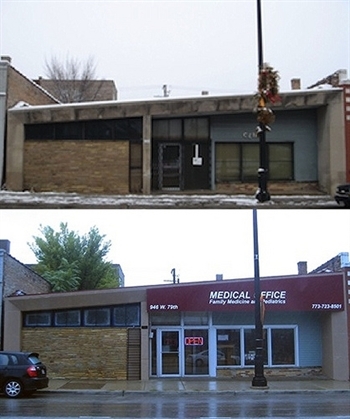
Dr. Selvam's medical office restored.
“It is hard to deny the power of visual impact: if we see an old building, it seems like we are in a dangerous place, but if we see a new façade design, we can see that the neighborhood is changing and becoming more affluent. People are attracted by the design—that’s the power of the program.” So says Donggyu Lee, a native Daegu, South Korea, and of one of four summer interns working on the façade enhancement program.
The façade enhancement program, one of the several GAGDC sponsored programs for Special Service Areas (SSA) 32 and 69, is facilitated by partner agency CJohnson and Associates as a part of their promotion of business interests in Auburn Gresham. An SSA is a local tax district that funds expanded services within the district with the help of a local organization. The GAGDC coordinates both SSA 32 and 69.

Mr. Sudsy's Laundry before the enhancements.
The Greater Auburn Gresham Development Corporation (GAGDC) is a nonprofit organization that promotes comprehensive community development in all or parts of Auburn Gresham, Ashburn, Englewood, Greater Grand Crossing, Washington Heights, West Englewood, and West Chatham. Through programs promoting education, housing, economic development, health and senior services, the GAGDC works to make Chicago resources more available and Chicago opportunities more equitable.
According to Cheryl Johnson, founder of CJohnson and Associates, CJohnson and Associates are “a community development consulting firm which specializes in leveraging human resources as well as financial resources that promote investment and development. We try to make an impact that people can actually see in our community.”
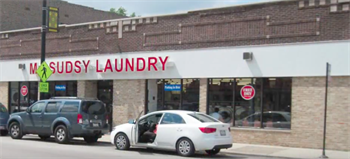
Mr. Sudsy's improved facade.
While this program is just one of many that the GAGDC and CJohnson and Associates provide for the two SSAs, it has special significance—as it gives the community a chance to see the brick and mortar improvements being made by engaged citizens and community-based organizations. The real power of the façade enhancement program is it changes the way the community thinks of itself, by making it more beautiful, the community gains two powerful things: pride in the growth of their neighborhood thus far, and hope in the growth to come. Without such tangible improvements, these two would be nigh on impossible.
These tangible improvements take a lot of work, and lucky for CJohnson and Associates, they have four tirelessly working interns this summer. These interns consult with business owners on improving the external appearance of their businesses and offer consultation and grants to restore storefronts inside of the SSA. The process of overhauling a façade can cost thousands of dollars—but through free consultations, design assistance, and grants, these interns can save business owners as much as $4000 dollars.
Furthermore, the interns are trained to inform about (and help business owners apply to) other grants and funding streams. They typically service five storefronts from each SSA every year—as well as help with a variety of other GAGDC and CJohnson and Associates projects, including the 79th Street Renaissance Fair, block-wide façade redesigns in partnership with the 6th, 17th and 21st wards and more.
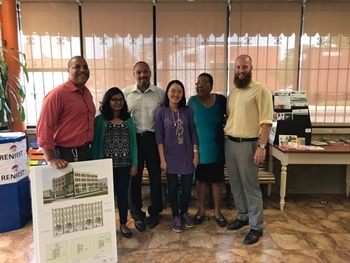
From left: Carlos Nelson (GAGDC executive director), Nivedha Jawahai, Kahyeem Anderson, Yu-Ping Sun, Cheryl Johnson and James Tarala. Photo credit: Donggyu Lee.
For the interns, this experience is both informative and moving. For Nivedha Jawahai, a University of Illinois at Chicago Urban Planning and Policy Major from Chennai, India, in the façade enhancement program, “you work on the building and you actually know why.” She was pleased to get the chance to apply her architectural skills more broadly, examining the effects of her work on the façade's urban surroundings. James Tarala, an undergraduate at the Illinois Institute of Technology, from Crown Point Indiana, is in his second summer in the program. Unlike his peers, he’s lucky because he has the chance to watch some projects come to fruition. When interns are only around for one summer, according to James, they “struggle to see the fruits of their labor.”

From right: Mr. Jasand Parker, Ms. Cheryl Johnson and Mr. James Tarala in front of Suite Little Feet.
Both last summer and this summer, James has had the chance to work with Jasand Parker, a new business owner in SSA 32. The Grand Opening of Mr. Parker’s new daycare, Suite Little Feet, is August 19th, but he has been consulting with James for more than a year. Unlike most clients, Mr. Parker took advantage of the program as he was starting his business—so instead of façade improvement, he offered the interns a chance to do façade design, and they stepped up to the challenge. After all, according to Mr. Parker: a beautiful façade “conveys a message that we not only care about the outside, we care about the inside. We care about the services we provide.”
Mr. Parker had a “very positive experience because the interns were very willing to learn and to help. James was the main person—he addressed all of my concerns and desires. My main designer was more hands-off than I was expecting, so I was glad I could lean on the interns; it worked out well that way.”
A native of the Southwest side of Chicago who had been in and around Auburn Gresham all his life, Mr. Parker still needed to familiarize himself with the business community here: “part of my job was to learn about support in the area. Sometimes it’s not easily seen what efforts are being done to promote businesses, you sort of have to just meet people and learn, but it was not hard to find the GAGDC—it’s a positive thing to see that there’s an agency promoting business.”
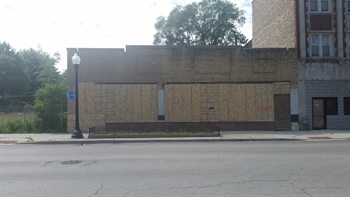
This is what Suite Little Feet looked like when Mr. Parker purchased it.
He said that while he wanted to take advantage of the “resources you don’t have to pay for” inside of the targeted area of SSA 32, the real reason he got involved was that he “wanted to go back to the commitment to the community” and community relationships. For Mr. Parker, “the financial is the cream on the cake.” Promoting community relationships was even more important to Mr. Parker’s strategy for opening his business—whether that was through substitute teaching at Cook Elementary School, or hiring from a list of local contractors provided by the GAGDC.
Even having a beautiful façade is a part of community engagement: “When you see buildings that are boarded up and dreary looking, that feel like there’s no potential or possibility, it's not welcoming.” After an improvement, however, “It looks like a whole new building, it brings a new energy to the space”—that “building becomes a work of art” for the community. For Mr. Parker, bringing art into the community energizes the block, the SSA and the neighborhood as a whole—it is as simple as this: “art is energy.

Suite Little Feet's artful facade.
Energizing the entire community, not just certain parts of it, is how Mr. Parker became interested in early childhood education in the first place: “I wanted to start at third grade and below so that I could have the most impact on African American students. That’s the only way you can work with a body of students; statistically, by third grade, you can tell the trajectory of where a kid is going to go. By the time I was a high school freshman, all my peers were weeded out.”
Kahyeem Anderson, a full-time associate at CJohnson and Associates, who has lived in Auburn Gresham for more than 20 years, has had time to watch that energy in motion. Referring to the intersection of 79th and Racine, near the GAGDC and CJohnson and Associates Offices, he explained: “if I can find anyone who can show you a picture of this intersection in 1990, you would not recognize it.” Now, Mr. Anderson hears “from the neighbors that the business owners are really stepping it up.”
However, Mr. Anderson understands that there is still a need for the program to continue: “most businesses in underprivileged communities are not consumer friendly; their façades are not inviting. The windows are cluttered and covered up… you’ll see all kinds of ‘window trash.’ I personally feel safer going into a building where I can see outside and people on the street can see inside. Sometimes you can’t even tell if there is a business there. I’m not going to investigate places where I can’t even tell if it is a business or not.”

The inside is as welcoming as the outside.
In engaged neighborhoods like Auburn-Gresham especially, when businesses do improve, it puts pressure on their neighbors—“If my neighbor gets his façade done, it will expose my business,” suggests Mr. Anderson. Improving entire blocks inside the SSA is hugely advantageous to local business: “It is in the best interest of our community to promote our local business…historically, everyone goes outside the community to shop because there’s not a lot of options.” Once businesses look more inviting and local, high-quality options become clear, customers will shop locally."
It’s this opportunity, to shop local, to engage locally both socially and economically, that inspires the façade enhancement program to reach its full potential. In a thriving business district, the mosaic of aesthetic styles of the storefronts comes to parallel the multifaceted connections between engaged neighbors. The health of these buildings facilitates the health of the connections. It is as if what Mr. Parker said about the SSA applies to the façades—yes building new façades will increase customers and foot traffic, but that’s only the cream on the cake. Once customers are in the door, the real power of the façade enhancements can take effect; they enhance the relationships between community members.
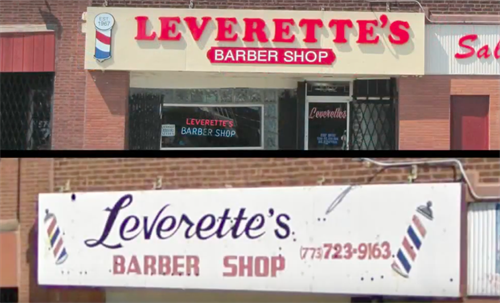
Posted in Business News, CAN TV, Community Highlights, Government Resources and Services, Housing/Real Estate